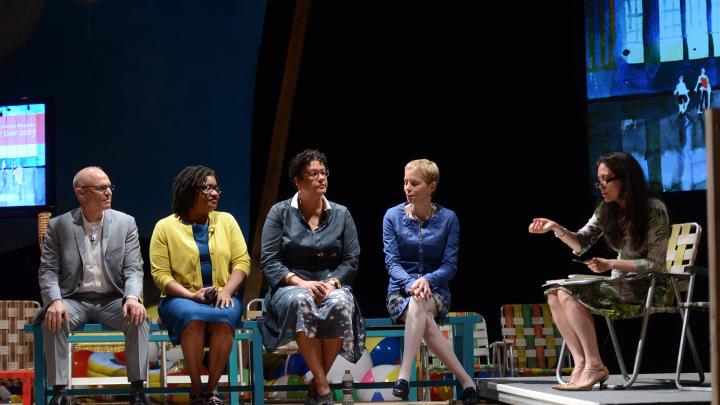Four different artists—a painter, poet, designer/photographer, and composer—discussed the creative process and the relationship between creators and their audiences to begin Radcliffe Day, on Friday, May 31, at the Loeb Drama Center. Diane Paulus, artistic director of the American Repertory Theater (ART) and professor of the practice of theatre at Harvard, moderated the discussion, titled “From Artist to Audience.”
The four discussants, all former fellows at the Bunting Institute or Radcliffe Institute for Advanced Study, were poet, essayist, and playwright Elizabeth Alexander, RI ’08; painter Beverly McIver, RI ’03; designer/photographer Mark Robbins, RI ’03, and contemporary composer Augusta Read Thomas, BI ’91. Alexander read her poem “Praise Song for the Day” at the 2009 inauguration of President Barack Obama, J.D. ’91—and gave a reprise at the Loeb. McIver and her mentally disabled sister Renee were the subject of a 2012 documentary, Raising Renee, directed by Jeanne Jordan, BI ’93, RI ’03. (The two met at the Radcliffe Institute.) Robbins is executive director of the International Center of Photography, and Thomas is one of the country’s most-performed classical composers. Examples of the works of all four creators were available as the audience took its seats. The discussion took place on the set of the current ART production of The Pirates of Penzance, prompting Lizabeth Cohen, dean of the Radcliffe Institute, to call the group, in her introduction, “the panelists of Penzance.”
Paulus, who has managed a very audience-friendly ART, suggested that the group “think about the audience as a partner and as an inspiring force.” In her own realm, she noted, “The audience is the event; theater cannot exist without an audience.” Each participant started with a 10-minute descriptive talk. McIver led off by observing that “being an artist is the hardest job I have ever had.” Among her goals for this year was to “schedule time to worry about money.” Using visual displays, composer Thomas covered “10 topics in 10 minutes” at breakneck pace, including audio excerpts from her haunting pieces. She confessed to being “very interested in clearness and sparkle…not so much in muddiness.” She declared that she tries to compose pieces in which “every musical element is aligned in a holistic gestalt.” Robbins reflected on his years as director of design at the National Endowment for the Arts: “four years in government, which is all we expected it to be—both Kafka and not.” Alexander described “a trustworthiness that art demands of its creators….you have to show up on time, and leave something at the altar of the ancestors.” She said that “poets make poems without the thought of an audience. Poems find their audiences in books, and journals. Then you get asked to compose a poem for the inaugural of Barack Obama, and suddenly the question of the audience is a wholly different one.”
Discussion followed, including questions from the Loeb audience. Alexander said that “The way I try to think of the audience is by making the best poem I can, as my humble offering.” Thomas, noting that “my work craves a listener,” described the “huge distance” between her creative process, which might take a year, and the 18 minutes when “an audience of 3,000 people hear it on one night.” Paulus raised the question of the “split brain” of the creator: part of the brain wrestles with artistic problems, but the other part worries about “how do we survive, how do we produce our works?” Robbins remarked upon the “vast democratization” of smartphone photography that, perhaps surprisingly, “only reinforces the place of the artist.”
“It’s not good enough anymore to just be a great painter,” McIver stated. “I have to seduce the person in front of me to get them to buy my work, to come to my show, or to review the exhibition.” Paulus asked if it were true that the U.S. government actually spends more on military bands than on all the other arts combined, and got a tentative confirmation from NEA veteran Robbins, who went on to the subject of how a work in progress is always on the creator’s mind: “It’s always percolating—it can’t be, ‘I have five minutes now, so I’m going to make a piece of art, and then go shopping.’ ” Thomas reflected on how she knows when a composition is complete. “I know when my pieces are finished,” she said, “when I can sleep through the night.”









